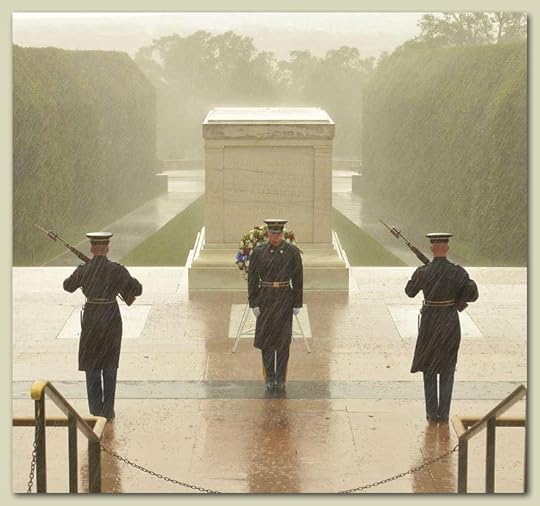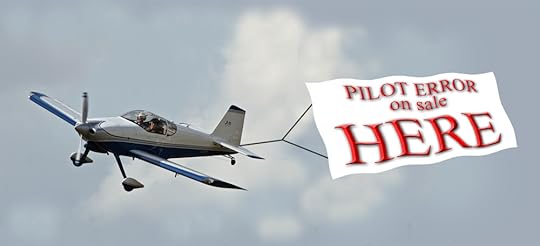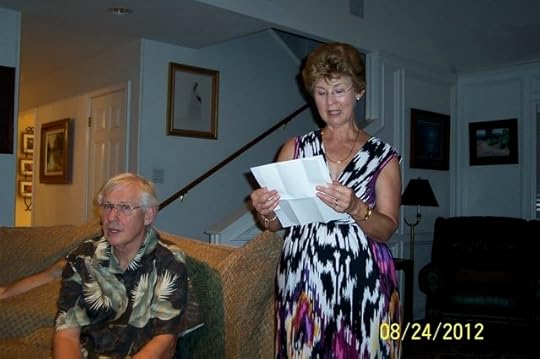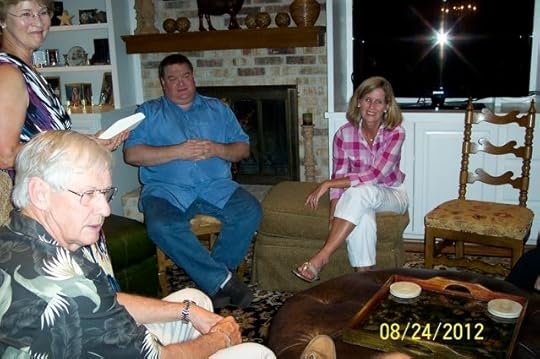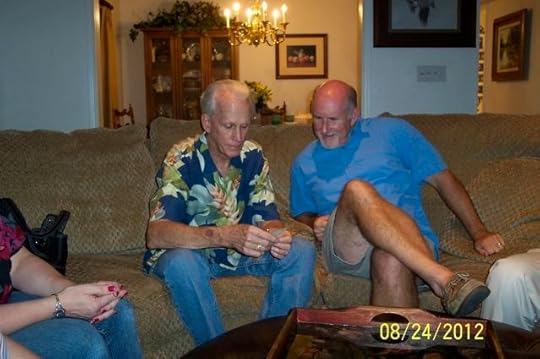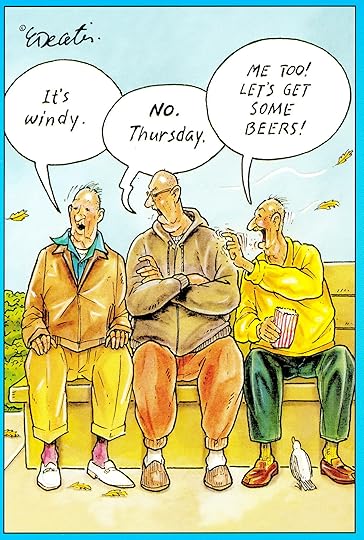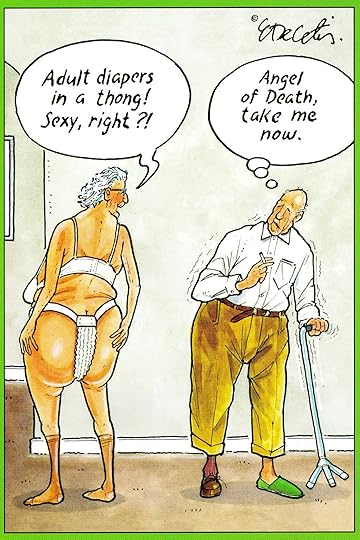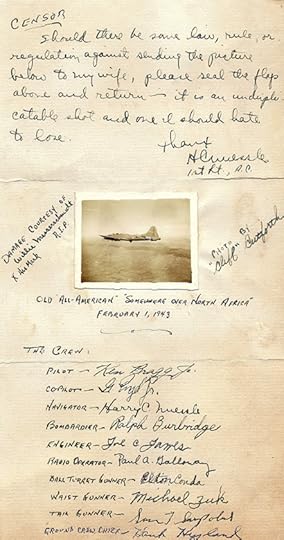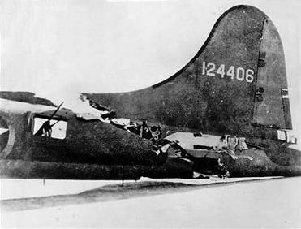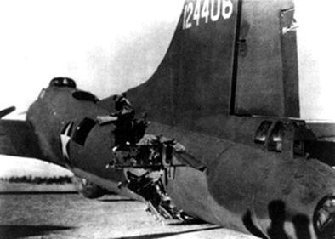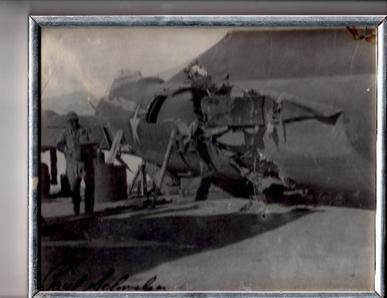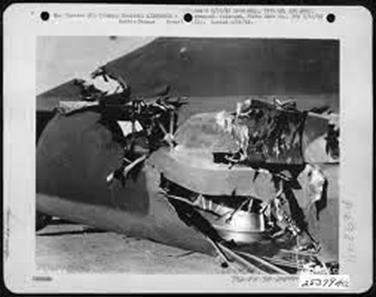Tosh McIntosh's Blog, page 8
November 1, 2012
Avoiding The Hammer
 Photo credit: Vixie79 @ fanpop.com
Photo credit: Vixie79 @ fanpop.com
Note: Featured Image Header photo credit: fltsim.com
All pilots, regardless of qualifications and amount of flight experience, know that Mother Nature rules the skies and has a nasty temper. She snarls at us in the form of wind, clouds, fog, rain, hail, snow and ice, turbulence, and lightning. Each of these weather hazards can ruin a pilot’s day in a heartbeat, and we are taught that whenever possible, avoidance is always the best tactic in dealing with them.
Absent an instrument rating and an airplane equipped to fly safely in the clouds without a visible horizon, avoidance typically means don’t fly today. Commercial pilots, however, have a job to do and are trained to deal with what we call instrument meteorological conditions (IMC). We can enter the clouds and areas of low visibility by reference to instruments that allow us to “keep the shiny side up,” a reference to the fact that the bottom of an airplane is usually dirtier than the upper surfaces. Many private pilots have instrument ratings as well, because it allows them to fly in less-than-ideal weather conditions and provides enhanced travel flexibility.
No matter what pilots want the non-aviator to think, none of us has x-ray vision, and clouds look exactly the same whether or not we have an instrument rating. What might be waiting behind the curtain is the problem, and pilots of large commercial aircraft deal with that uncertainty by using on-board color-weather doppler radar.
This technology detects water in the air, and more importantly, the amount and movement of the water, and displays the area of weather in front of the aircraft with green, yellow, orange, red, and magenta to indicate the intensity of the hazard.
Without turning this post into a meteorology lesson, suffice it to say that all the violent weather on the planet uses water for fuel and results from the collision of two (or more–ever heard of Hurricane Sandy?) air masses with different temperature, barometric pressure, and humidity.
Not so long ago, the only way a pilot in an aircraft without on-board weather radar could determine the potential dangers ahead inflight was to contact an air traffic controller or weather specialist on the radio. The typical description might be something like:
“From 40 miles north-northeast of the Stonewall VOR to 50 miles east of the Centex VOR to 20 miles northeast of the Humble VOR to 30 miles southwest of the San Antonio VOR an area of level 4 and 5 thunderstorms moving northeast at 35 knots with tops to 45,000 feet.”
Try copying that down, much less plotting it on a map or interpreting it in your brain.
Enter one of the most significant advancements in weather-avoidance technology for smaller airplanes: satellite weather images right there in front of you on a screen, that can also display your planned course line, navigation aids, airports, etc. How in the world do they do that?
The process uses images from a number of satellites in geosynchronous orbit to create a composite image, which is then transmitted to an antenna on the aircraft for display in the cockpit. No more dealing with a word-salad description of the storms. It’s right there on the instrument panel, so the pilot can turn to avoid the weather and navigate around it.
I’ve inserted a link at the end of this post to an excellent video produced by the Air Safety Institute, a division of the Aircraft Owners and Pilots Association. This case study vividly illustrates the potentially tragic effect of time lapse.
Unlike real-time on-board color-weather radar displays, satellite weather information is always a delayed snapshot. Display screens are designed to give the pilot an indication of how old the image is by providing a count-up timer, which tells you how long it’s been since the image was uploaded to your screen, not since the data was collected.
This may seem to be a limitation that renders the data useless, but in reality, satellite weather is an essential tool so long as pilots take time lapse into account. This case study documents the circumstances surrounding an encounter with violent weather that killed the pilot and passengers of a Cherokee Six that went down over southeast Texas in late 2011.
This is not a story of pilot incompetence, or lack of training, or failure to maintain currency. It does, however, indicate questionable judgment and the possible effect of a condition that pilots call get-home-itis. I’m speculating, but why else would a pilot elect to continue toward his final destination after a long day of flying, at night and in bad weather that included a monster area of thunderstorms? The answer to that question also has to include confidence in his ability to avoid the storms using on-board satellite weather data. He had no intention of flying into dangerous weather, which is exactly what he did.
Seven critical factors form the links in the chain of events.
The area of weather was moving from the southwest at about 45 knots (52 mph).
The Cherokee Six cruises at 135-155 knots depending on the power setting.
The pilot had skirted the area of weather to the southeast and had turned back to the west to get behind the storms for a landing at his destination.
Against a significant headwind, his speed over the ground had dropped to less than 100 knots.
The weather data had appeared on his display over 8 minutes before the accident.
Time lapse had considerably aged the data to further reduce its currency.
In 8 minutes plus the time lapse, the storm could have moved as much as 10 miles.
In the final analysis, the pilot mistakenly thought he had safe clearance from the storm, and he flew into an area that would have been colored magenta if the data on the screen had been more current. Turbulence subjected the Cherokee to aerodynamic loads in excess of structural limits and snapped off a wing.
Of all the hazards to aviation Mother Nature can place in a pilot’s way, a thunderstorm’s hammer is without question the most dangerous. For an in-depth view of how this tragedy unfolded, click on the link below. It contains analysis, radar tapes showing the storm in relation to the flight path of the doomed aircraft, and recordings of pilot-to-controller communications.
October 31, 2012
Benefits of Yoga vs. Liquor
Finally, research confirms that drinking offers the same benefits as yoga. Don’t believe it? Here’s the proof:
Savanna position of total relaxation
 Balasana position that brings the sensation of peace and calm
Balasana position that brings the sensation of peace and calm
 Setu Bandha Sarvangasana position calms the brain and heals tired legs
Setu Bandha Sarvangasana position calms the brain and heals tired legs
 Marjayasana position stimulates the midriff and spinal column
Marjayasana position stimulates the midriff and spinal column
 Halasana position excellent for back pain and insomnia
Halasana position excellent for back pain and insomnia
 Dolphin position excellent for the shoulders, thorax, legs and arms
Dolphin position excellent for the shoulders, thorax, legs and arms
 Salambhasana position to stimulate the lumbar area, legs, and arms
Salambhasana position to stimulate the lumbar area, legs, and arms
 Ananda Balasana position for massaging the hip area
Ananda Balasana position for massaging the hip area
 Malasana position for ankles and back muscles
Malasana position for ankles and back muscles
 So, life really boils down to two questions . . .
So, life really boils down to two questions . . .
1. Should I get a dog?
Just to let you know that I’m thinking of you today,
No matter what life throws at you,
No matter how long and treacherous your journey may seem,
Remember that there is a light at the end of the tunnel.
That’s good, because my job here is done.
Have a great day and remember to give thanks . . .
Cats are so dramatic!
October 30, 2012
When Foul Winds Blow . . .
October 29, 2012
Texas Book Festival – 2012
DAY ONE:
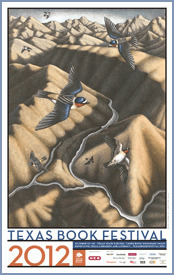 It’s Sunday morning, October 28, 2012, and sitting at my computer with my first cup of coffee, I couldn’t resist the temptation to document a few personal observations from my experience in the Violet Crown Publishers booth at the halfway point of the Texas Book Festival weekend.
It’s Sunday morning, October 28, 2012, and sitting at my computer with my first cup of coffee, I couldn’t resist the temptation to document a few personal observations from my experience in the Violet Crown Publishers booth at the halfway point of the Texas Book Festival weekend.
This being my first time attending in any capacity, I had little advance notion of what to expect. Cynthia Stone, her good friend and fellow author Beth Fowler, and yours truly had spent the previous afternoon and last-minute preparation time that morning hauling all the books, poster display grids, posters, chairs, two tables, and small giveaway promotional materials from my truck into the exhibition tent and trying to make everything fit in a limited space. Lara Reznik, jetlagged and coughing, skillfully avoided the set-up chaos by just having returned from a vacation in Europe with her husband Rudy. I’m joking, of course, and luckily she recovered sufficiently after a night’s rest at home to join us before the festival began.
 I’m no good at the visualization of how the booth should look, so my role became that of a helper. Which is a good thing, because my compulsion to straighten everything up would have been completely incompatible with the carefully designed look of clutter on the big eight-foot table supplied by the festival. Books, books, and more books. Not like Penguin, USA in the booth close by, of course. They filled about three booths on our side of the tent and one or two across the aisle. But for an itty-bitty indie operation, especially with the poster display designed by Cynthia, we had no reason to hang our heads.
I’m no good at the visualization of how the booth should look, so my role became that of a helper. Which is a good thing, because my compulsion to straighten everything up would have been completely incompatible with the carefully designed look of clutter on the big eight-foot table supplied by the festival. Books, books, and more books. Not like Penguin, USA in the booth close by, of course. They filled about three booths on our side of the tent and one or two across the aisle. But for an itty-bitty indie operation, especially with the poster display designed by Cynthia, we had no reason to hang our heads.
Truth be told, I expected to spend seven hours in the booth twiddling my thumbs while shoppers bought all the other books on the table. My three would be sitting in lonely stacks, forlorn and pitifully indicative of no one’s interest. I didn’t know where to stand. The booths are small, with narrow spaces on both sides of the display table, and no matter where I decided to park, I didn’t want shoppers to feel as if they stepped inside, I’d be on them like a used-car salesman who doesn’t understand “Just looking” and becomes a shadow.
At one point early in the first hour, a shopper stops and picks up Lara’s The Girl From Long Guyland. Beth makes eye contact with Lara and mouths something like (and I paraphrase with embellishment), Pounce on him and sell your book! Lara and I talked a little about this tactic and agreed that we weren’t comfortable doing that.
A little while later someone stops and picks up Pilot Error. My heart climbs into my throat as I get ready for the first of what I expect to be many rejections during the day. But this time, Beth uses a different tactic. Rather than wasting her efforts on me, she steps up to the guy and says, “If you’d like to meet the author, he’s standing right here.”
That’s my cue! I shake hands, we talk a bit, and in a drop-my-jaw move, he asks me how much.
“I have a special for you today, sir. You can purchase the novel and receive my two small non-fiction books on flying and writing in a bundle for only ten bucks. Now that’s a deal, don’t you think?”
Lo and behold, wonder of wonders, he agrees.
Enter the tag-team approach to greeting visitors to the booth. Here’s how it worked:
Someone stops and picks up one of the four novels at the head of the table from a stack of a few lying flat with a copy front cover out on an easel, bookmarks casually lying between each book.
Secret eye-signals pass between the authors. An author who didn’t write the book engages the visitor in casual conversation, always with the message that the author who did is close by.
Nine times out of ten, the visitor made eye contact, accepted a handshake, and engaged with us.
I’ve got one day of the book festival behind me and have no business making any observations of import, but a little knowledge has never stopped me before.
I’m an unknown author with unheard of books, and although visitors can be attracted to a cover, flip the book over and read the back-cover description, open the book and read a little of the first chapter, they still have to get past the natural reticence of never having heard of Tosh McIntosh.
Seven hours of standing in that booth has convinced me that personal contact, beginning with a question or two directed at the visitor rather than an immediate sales spiel, opens the door. I often asked the visitor if he or she might be a pilot and/or a writer, and in every case, the conversation shifted easily to what the book was about. And in retrospect, I believe that the author’s passion for the book is the key to generating enough interest for the visitor to take a chance with their money.
My bundling tactic has to be considered as well. I sold three books together for an amount that barely covers my cost to pay for the copies and the shipping. But it’s not about the money, and never will be for the vast majority of indie or legacy authors.
A book festival is about promotion. Most if not all of my writer friends might read this and think (or more likely say), “Are you just now figuring this out, Tosh?”
Well, yeah. I’m a slow learner, I guess. But in the final analysis, whether or not any of the buyers recommend my books to their friends and assist with promoting it, this has been (and will be today) an amazing experience.
DAY TWO:
With another day at the festival under my belt, for a total of 13 hours in the booth, I can report that except for what John Candy in the movie “Planes, Trains, and Automobiles” called “barking dogs” in referring to his sore feet, the experience was positive and enjoyable. One unexpected benefit turned out to be multiple opportunities for practicing my spiel when someone asks me what the story is about.
Writers are advised to have ready at a moment’s notice what is called a “30-second elevator pitch,” a term derived from the following scenario at a writers’ conference, and which assumes that the writer’s goal is to get an offer of representation from a literary agent:
You didn’t get a one-on-one consultation with your dream agent, so you’ve studied a photograph well enough to recognize him or her no matter how out of date the glamour shot happens to be. Throughout the conference, you’ve been on the stalk, watching, waiting for an opportunity that never seems to come.
You’ve seen the agent from afar a few times, surrounded by concentric circles of pushy writers all clamoring for the agent’s attention. The conference ends in a few hours, and you’ve all but given up. One last panel discussion you’d like to attend meets on the fourth floor in five minutes, and you’re rushing to get there.
The elevator door opens, you step inside without making eye contact with the only other occupant, stab the button labeled “4″ and glance at the person beside you to offer a casual greeting and holy Toledo! It’s your dream agent come true.
Panic seizes your tongue, sweat instantly covers your brow, and all you can do is stare at the elevator door even though you know that this is it, the one and only time you’ll probably have to pitch your novel to the agent you are convinced will love it. And without that pitch ready, forget about it.
Standing in the booth at the festival, however, visitors are coming to you and you have an opportunity to give it your best shot at generating in a complete stranger sufficient interest in your book to result in a sale. By the end of the festival, I had it down pretty well and felt comfortable with how it was being received.
Practice means little, however, when dealing with some folks. Here are some comments:
“So, this is a novel?”
“Have you read — by —? It has a lot about airplane accident investigation in it.”
“A friend of mine runs a salvage company specializing in aircraft wreckage. He knows all about aviation accident investigation. I’m sure he’d be glad to help you out, and I’ll give you his contact information if you’d like to talk with him.”
“I read this book that said there are always five pilot mistakes leading up to any accident.”
“Well, you know, once a pilot gets over about 350 hours of flight time, he usually has enough experience to avoid making mistakes.”
Spare me, please. But I didn’t say that, of course. I smiled, nodded, played like the little dog in the rear window of a car with my head bobbing in agreement.
Cynthia J. Stone and Lara Reznik of Violet Crown Publishers, Beth Fowler and I talked a lot about the booth layout and came up with a number of ideas for the future. With limited space and four authors hovering about, what the visitors can see to attract their attention and how they approach the booth, enter if they need to, and exit, all have to be carefully considered.
And although we’re convinced we can do better, we received evaluations from others noting that the poster display on the free-standing grids at the rear of the booth was extremely effective, and we appeared to have more visitors hanging around and talking than many of the other booths. I have no idea if that’s true or not, because as reported in my Texas Book Festival halftime report, I never left the booth to see what other writers/publishers had done. My objective was to promote my books, and I couldn’t do that while absent from the scene.
All in all, the festival experience was well worth the time and effort, and we’re talking about not waiting for October, 2013 to attend our next one.
September 10, 2012
Aviator Sayings
Pilots: People who drive airplanes for other people who can’t fly.
Fighter Pilots: Cold, steely eyed, weapons systems managers who kill bad people and break things. However, they can also be very charming and personable. The average Fighter Pilot, despite sometimes having a swaggering exterior, is very much capable of such feelings as love, affection, intimacy and caring. These feelings generally just don’t involve anyone else.
Words of Wisdom From Aviators:
Flying is a hard way to earn an easy living.
Both optimists and pessimists contribute to society. The optimist invents the airplane; the pessimist, the parachute.
If helicopters are so safe, how come there are no vintage helicopter fly-ins?
Death is just nature’s way of telling you to watch your airspeed.
Real planes use only a single stick to fly. This is why bulldozers and helicopters—in that order—need two.
There are only three things the copilot should ever say:
Nice landing, Sir.
I’ll buy the first round.
I’ll take the fat one.
As a pilot only two bad things can happen to you and one of them will be:
One day you will walk out to the aircraft knowing that it is your last flight.
One day you will walk out to the aircraft not knowing that it is your last flight.
Regarding aircraft, there are Rules and there are Laws. The Rules are made by men who think that they know better how to fly your airplane than you. Laws (of Physics) were ordained by God. You can, and sometimes should, suspend the Rules, but you can never suspend the Laws.
About Rules:
The rules are a good place to hide if you don’t have a better idea and the talent to execute it.
If you deviate from a rule, it must be a flawless performance. If you fly under a bridge, for example, don’t hit the bridge.
The ideal pilot is the perfect blend of discipline and aggressiveness.
The medical profession is the natural enemy of the aviation profession.
Ever notice that the only experts who decree the age that a pilot’s career is over are people who have never flown anything?
In spite of the intensity of some experts opinions that the era of the pilot is over, I know of none who has volunteered to be a passenger in a non-piloted aircraft.
Before each flight, make sure that your bladder is empty and your fuel tanks are full.
In the Alaskan bush I’d much rather have a two-hour bladder and three hours of gas than vice versa.
He who demands everything that his aircraft can give him is a pilot. He who demands one iota more is a fool.
There are certain aircraft sounds that can only be heard at night.
The aircraft limits are only there in case there is another flight by that particular aircraft. If subsequent flights do not appear likely, there are no limits.
“If the Wright brothers were alive today, Wilbur would have to fire Orville to reduce costs.” —President, DELTA Airlines.
It’s not that all airplane pilots are good-looking. It’s just that good-looking people seem more capable of flying airplanes.
An old pilot is one who can remember when flying was dangerous and sex was safe.
Airlines have really changed. Now a flight attendant can get a pilot pregnant.
I’ve flown in both pilot seats, and I don’t understand this. Can someone tell me why the other one is always occupied by an idiot?
There are only two types of aircraft – fighters and targets.
The scientific theory I like best is that the rings of Saturn are composed entirely of lost airline baggage.
Flying is a great way of life for men who want to feel like boys, but not for those who still are.
The other side of that coin: “Son, you’re going to have to make up your mind about growing up and becoming a pilot. You can’t do both.”
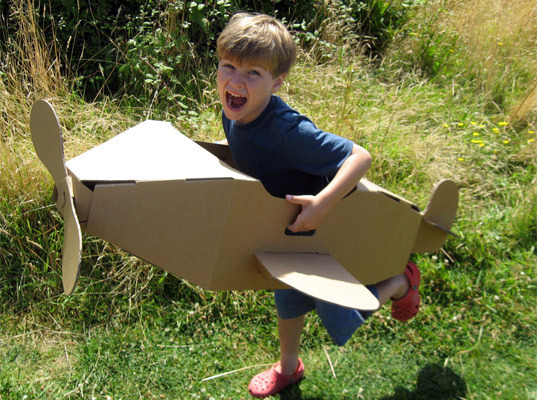 Image from inhabitots.com, airplane by Cardboard Design
Image from inhabitots.com, airplane by Cardboard Design
September 6, 2012
Book Clubbing Around the Neighborhood
I live on a cul-de-sac, an arrangement of homes that in my experience tends to concentrate interactions with neighbors. Within a few weeks of publishing my first novel, I jokingly mentioned to a friend (not a neighbor) that I was considering a sign in the front yard advertising the book as being for sale online, at BookPeople in Austin, Texas, and from the front door of this house with the author’s signature at no extra charge.
I didn’t give in to that marketing temptation, but even without it, the word got out that I had published a book. I’m not sure, but maybe the towed banner had something to do with it.
No matter the reason, one of my neighbors approached me earlier this summer and asked if I would be interested in having my novel read by a book club. She told me that the members were all women with kids, they didn’t meet during the summer, but how about September 4th? All I’d have to do is walk about 20 yards, join them for wine and dinner, and make sure I brought my body armor for the discussion. (Not really.)
Tempting as that sounded, I thought it best to warn her that my novel had some hard language and character actions, and I would hate for anyone to be offended.
“I don’t think you need to worry,” she said. “The last book we read was Fifty Shades of Grey.”
I haven’t read it, but I knew enough to conclude that nothing in Pilot Error would come even close. So we agreed on the time, and this last Tuesday I met with nine ladies around a table, drank some wine, ate Spaghetti Bolognese and Caesar Salad, and spent almost three hours talking about, well, my novel.
There’s a cartoon about that. It shows a man, dressed in Hollywood black chic, of course, standing in a room crowded with people sitting in chairs, on the floor, every one of them gazing at him with rapt attention. The caption reads:
“Well, enough about me. Let’s talk about my novel!”
I can report that the experience was and will forever remain one of the most memorable events of my writer’s journey. Their comments and questions targeted the heart of story telling, and if I had closed my eyes and simply listened, I might have concluded that the conversation had been recorded during one of my weekly writers’ critique group meetings a few houses away.
For the purposes of my own exploration of the craft, I’ve identified 26 structural elements of modern western fiction that I believe define the underpinnings of good stories well told. The discussion addressed at least a third of them, especially impressive considering that as far as I know, only one of the members of the club is a writer. I couldn’t have scripted the discussion any better. Except maybe to add a few more instances of genuflection.
So, based on this experience, I hereby announce that I . . .
August 28, 2012
That Was When I Was A Lot Older Than I Am Now
Moms and Dads love telling stories on their kids, right? The cute things they said and did, the more embarrassing to the child as an adult, the better.
On the occasion of my big Seven–O birthday, my wife Ann announced that she had a presentation to make and asked everyone to take a seat in the living room. She opened an envelope and immediately began to tear up as she tried to explain that my brother had found among our parents’ effects two small note cards upon which our father had written the most memorable (to our parents) sayings for each of us.
Ann wanted to read them, stumbled a few times, rejected an offer from the group to handle the job, and ultimately made it through the list.
Here are the front and back of my card:
Another one choo-choo
You’re too heavy, put me down
Merry-go-we-wound
Grud Store
Shun Spuger
Handsome and Gretel
Smackey Mack [An imaginary friend]
Skub Couts
That was when I was a lot older than I am now [A saying I apparently used whenever telling tall tales of my adventures during the day. One in particular that frequently made the parents-tell-stories-on-their-kids nights was about me being a famous big-game hunter with fresh meat hanging from my belt.]
Upside downside up cake
Short sleeved pants
Middle hind catcher with three hats.
 I haven’t seen my brother’s card, but he says it’s hidden away. By Dad or him, I’m not sure. Maybe it’s because all of mine are cute and his are simply too embarrassing for an older brother?
I haven’t seen my brother’s card, but he says it’s hidden away. By Dad or him, I’m not sure. Maybe it’s because all of mine are cute and his are simply too embarrassing for an older brother?
Here are some photos from the presentation.
Ann and her brother-in-law Dr. Bill Evans
Dr. Bill, Ann, Lloyd Bates, Kathy Brown (Ann’s daughter) and the sun rising early in our TV
The youngster looking at the card for the first time in many, many years. Tosh Brown (Ann’s son-in-law) looks on.
Lloyd Bates, Kathy Brown, Pat Evans (Ann’s sister), Reed Bates (Ann’s niece) and Katie Evans (Dr. Bill’s daughter) look on as the old man contemplates his father’s handwriting on a little card.
Laughter is always the best medicine for old age.
August 25, 2012
How To Crash An Airplane–Doomed From The Start
The pilot of the airplane in this video didn’t visit my website to tell his story, but he’s very lucky to have that opportunity in the future should he choose to do so.
In case you don’t already know it, pilot error is a factor in about 85% of all aircraft mishaps, incidents, and crashes. Note that although we may call it “accident” investigation, that’s a misnomer, at least according to the second definition listed in one of my dictionaries: an event that happens by chance or that is without apparent or deliberate cause. In one very real sense, if an event is avoidable, it’s not an accident when it happens.
Throughout my career as a pilot and continuing to this day in sport aviation, inviolate rules apply when taking to the air. At the most basic level, all an aviator has to do is abide by the very first item in the very first set of flying regulations published by the United States Army Air Corps:
No pilot will attempt a takeoff unless he is convinced the machine will fly.
Pretty basic, right? And yet based on the statistic in the second paragraph above, it should come as no shock that crashes do occur when pilots attempt a takeoff that is doomed from the start. Such is the case in the video accessed from the link at the end of this post.
By way of introduction to what you will see, consider the following:
Both piston and jet airplane engines produce horsepower/thrust by combustion, which requires air, a fuel source, and ignition.
Oxygen is the ingredient in air that supports combustion. Cold, sea-level air is dense, which means that the molecules of oxygen are closely packed together with more of them in any given volume. Translation: greater horsepower/thrust from the engine. Warm, high-altitude air found at mountain airports in the summer is less dense and produces the opposite effect. Translation: be careful when attempting a takeoff in high, hot atmospheric conditions.
Any fixed-wing airplane (i.e., not a helicopter or airship) behaves in the air through an interaction of four forces: thrust, drag, weight, and lift. Thrust has to be equal to/greater than drag to maintain/increase speed. Lift has to be equal to/greater than weight to maintain/increase altitude. (From a pure aerodynamic standpoint, an airplane climbs because of excess thrust, not lift, but that explanation is irrelevant to this discussion.)
For any given airplane to takeoff successfully under any given atmospheric conditions, the combination of horsepower/thrust available and lift in excess of that required to maintain level flight must be sufficient to become airborne and climb.Translation: don’t load an airplane up with people, fuel, and bags and try to takeoff from a mountain airport on a hot day without ensuring that the machine will fly!
The video is graphic documentation of a pilot-in-command’s failure to abide by the most basic of aviation rules. Multiple cameras record the flight and crash from within the airplane. All occupants survived, but there are a couple of moments with views of the pilot’s facial injuries.
The video is less than 10 minutes long, but it has a few minutes of dark video immediately after the crash when the camera was running and the occupants weren’t doing a lot of moving about. Then it picks up after they exited the airplane.
Here’s the link and the original description:
This is unprecedented footage of a small airplane crash from inside the cockpit from two different views. Miraculously, everyone survived. The pilot will make a full recovery and the rest of us escaped with superficial injuries and feel very lucky to be alive. This trip was much anticipated and due to our excitement we had our Gopro cameras filming at various times. After flying up into the mountains for a hike in the Frank Church River of No Return Wilderness we were planning on flying to a small mountain town for dinner. Due to warming temperatures we had a hard time gaining altitude. After taking off we hit an air pocket that made us rapidly loose altitude, pushing us down into the trees [italics added]. [Tosh note: the italicized text is hogwash.]
Credit: outdoors to stay
The Big Seven-O
We only experience any birthday once in a lifetime, but some obviously arrive with more significance than others.
My 60th year was not a good time for me. I found myself looking back with regrets about what might have been and forward with pessimism about what the future might hold. The day in the middle representing current time therefore became prime territory for depression, a condition with sufficient history in my family to be of concern. Fortunately, the ill effects of that milestone didn’t continue.
My brother is six years older, but for the 20 days between his birthday and mine, I’m able to take advantage of the extra year’s difference by sending him the tackiest birthday cards I can find.
Let the record show, however, that I didn’t start what has become a twice yearly tradition. It’s all his fault, beginning with a card with the following image on the front:
A figure stands in a black, hooded robe. Under the hood are two blood-red eyes and nothing else. From the right sleeve extends a skeletal hand gripping a long-staffed scythe. And on the inside, the following inscription:
YOU CAN RUN, BUT YOU CANNOT HIDE
Okay, so each year we try to outperform the other with our birthday greetings. On a few occasions I’ve come close to bettering him, but he still has the edge, which he extended this year with three cards I’ll share with you here.
The bad news? I’ll have to wait a year for another attempt at gaining the upper hand.
And the next card is from my lovely wife, who isn’t immune from the tacky card syndrome, but she softens the blow with a few nice ones like this.
Ann added the birthday greeting to the front of this card in keeping with a much nicer family tradition begun some years ago by her sister, Pat Evans, with greetings such as, “64 and ready for more,” “65 and still alive,” etc., until this year when she offered the one Ann used above. Thank you, Pat!
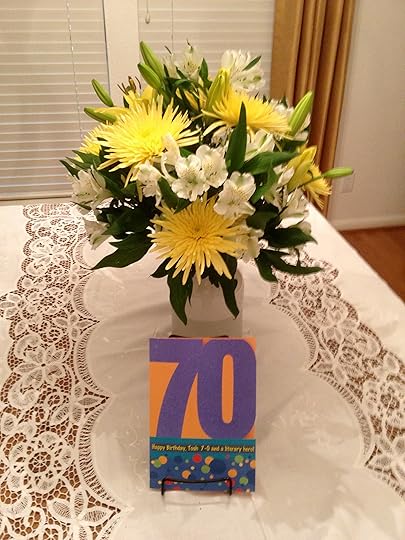

 And a final thanks to all who offered birthday greetings and the family who gathered at Abuelo’s for dinner and here for two cakes! Pat’s daughter-in-law Katie Evans has a birthday very close to mine and we tend to combine the celebrations. Great fun was had by all.
And a final thanks to all who offered birthday greetings and the family who gathered at Abuelo’s for dinner and here for two cakes! Pat’s daughter-in-law Katie Evans has a birthday very close to mine and we tend to combine the celebrations. Great fun was had by all.
August 23, 2012
A B-17 All American Story
If you have visited this logbook in the past, you may know that my original intent for it has changed. The idea was to attract visitors with stories to tell about their experiences in aviation either as a passenger, a pilot, or both. A few of my friends offered content to help me get the logbook up and running, but it quickly became apparent that the number and type of visitors to my site couldn’t support the concept.
 To deal with that reality, I decided to use the term “visitor” a bit loosely and post stories of interest that had been published elsewhere. They’re like passersby who have been shanghaied off the street by an aggressive merchant, if you will. That’s me, armed with one of those stage hooks.
To deal with that reality, I decided to use the term “visitor” a bit loosely and post stories of interest that had been published elsewhere. They’re like passersby who have been shanghaied off the street by an aggressive merchant, if you will. That’s me, armed with one of those stage hooks.
The following story has made the rounds more than once, but it’s worth whatever added exposure I can provide. Please take a moment to read it, and the next time you chance upon someone who appears to be one of the greatest generation, take the opportunity to shake hands with the last of the breed. It won’t be long before you’ll never get another chance.
And now, the harrowing story of the “All American”:
B-17 “All American” (414th Squadron, 97BG) Crew
Pilot- Ken Bragg Jr.
Copilot- G. Boyd Jr.
Navigator- Harry C. Nuessle
Bombardier- Ralph Burbridge
Engineer- Joe C. James
Radio Operator- Paul A. Galloway
Ball Turret Gunner- Elton Conda
Waist Gunner- Michael Zuk
Tail Gunner- Sam T. Sarpolus
Ground Crew Chief- Hank Hyland
A mid-air collision on February 1, 1943, between a B-17 and a German fighter over the Tunis dock area became the subject of one of the most famous photographs of World War II.
An enemy fighter attacking a 97th Bomb Group formation went out of control, probably with a wounded pilot, then continued its crashing descent into the rear of the fuselage of a Fortress named All American, piloted by Lt. Kendrick R. Bragg, of the 414th Bomb Squadron.
When it struck, the fighter broke apart, but left some pieces in the B-17. The left horizontal stabilizer of the Fortress and left elevator were completely torn away. The two right engines were out and one on the left had a serious oil pump leak. The vertical fin and the rudder had been damaged, the fuselage had been cut almost completely through, connected only at two small parts of the frame. The radios, electrical and oxygen systems were damaged. There was also a hole in the top that was over 16 feet long and 4 feet wide at its widest, and the split in the fuselage went all the way to the top gunner’s turret.
Although the tail actually bounced and swayed in the wind and twisted when the plane turned and all the control cables were severed except for a single elevator cable, the aircraft still flew. The tail gunner was trapped because there was no floor connecting the tail to the rest of the plane. The waist and tail gunners used parts of the German fighter and their own parachute harnesses in an attempt to keep the tail from ripping off and the two sides of the fuselage from splitting apart. While the crew was trying to keep the bomber from coming apart, the pilot continued on his bomb run and released his bombs over the target.
When the bomb bay doors were opened, the wind turbulence was so great that it blew one of the waist gunners into the broken tail section. It took several minutes and four crew members to pass him ropes from parachutes and haul him back into the forward part of the plane. When they tried to do the same for the tail gunner, the tail began flapping so hard that it began to break off. The weight of the gunner was adding some stability to the tail section, so he went back to his crew position.
The turn back toward England had to be very slow to keep the tail from twisting off. They covered almost 70 miles to make the turn home. The bomber was so badly damaged that it was losing altitude and speed and was soon alone in the sky. For a brief time, two more Me-109 German fighters attacked the All American. Despite the extensive damage, all of the machine gunners were able to respond to these attacks and soon drove off the fighters. The two waist gunners stood up with their heads sticking out through the hole in the top of the fuselage to aim and fire their machine guns. The tail gunner had to shoot in short bursts because the recoil was actually causing the plane to turn.
Allied P-51 fighters intercepted the All American as it crossed over the Channel and took one of the pictures shown. They also radioed to the base, describing that the empennage was waving like a fish’s tail, the plane would not make it, and to send out boats to rescue the crew when they bailed out. The fighters stayed with the Fortress, taking hand signals from Lt. Bragg and relaying them to the base. Lt. Bragg signaled that 5 parachutes and the spare had been “used” so five of the crew could not bail out. He made the decision that if they could not bail out safely, then he would stay with the plane and land it.
Two and a half hours after being hit, the aircraft made its final turn to line up with the runway, still over 40 miles away. The aircraft commander carefully guided the crippled bomber to an emergency landing and a normal roll-out on its landing gear.
When the ambulance pulled alongside, it was waved off because not a single member of the crew had been injured. No one could believe that the aircraft could still fly in such a condition. The Fortress sat placidly until the crew exited through the door in the fuselage and the tail gunner had climbed down a ladder. A that moment, the entire rear section of the aircraft collapsed onto the ground. The rugged old bird had done its job.





